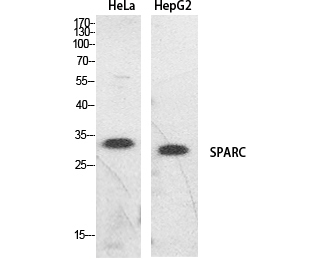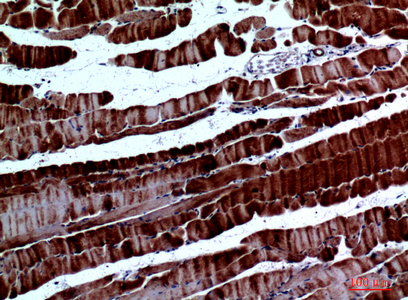SPARC Polyclonal Antibody
- Catalog No.:YT5521
- Applications:WB;IHC;IF;ELISA
- Reactivity:Human;Mouse;Rat
- Target:
- SPARC
- Gene Name:
- SPARC
- Protein Name:
- SPARC
- Human Gene Id:
- 6678
- Human Swiss Prot No:
- P09486
- Mouse Gene Id:
- 20692
- Mouse Swiss Prot No:
- P07214
- Rat Gene Id:
- 24791
- Rat Swiss Prot No:
- P16975
- Immunogen:
- The antiserum was produced against synthesized peptide derived from the Internal region of human SPARC. AA range:141-190
- Specificity:
- SPARC Polyclonal Antibody detects endogenous levels of SPARC protein.
- Formulation:
- Liquid in PBS containing 50% glycerol, 0.5% BSA and 0.02% sodium azide.
- Source:
- Polyclonal, Rabbit,IgG
- Dilution:
- WB 1:500 - 1:2000. IHC: 1:100-1:300. ELISA: 1:20000.. IF 1:50-200
- Purification:
- The antibody was affinity-purified from rabbit antiserum by affinity-chromatography using epitope-specific immunogen.
- Concentration:
- 1 mg/ml
- Storage Stability:
- -15°C to -25°C/1 year(Do not lower than -25°C)
- Other Name:
- SPARC;ON;SPARC;Basement-membrane protein 40;BM-40;Osteonectin;ON;Secreted protein acidic and rich in cysteine
- Observed Band(KD):
- 34kD
- Background:
- This gene encodes a cysteine-rich acidic matrix-associated protein. The encoded protein is required for the collagen in bone to become calcified but is also involved in extracellular matrix synthesis and promotion of changes to cell shape. The gene product has been associated with tumor suppression but has also been correlated with metastasis based on changes to cell shape which can promote tumor cell invasion. Three transcript variants encoding different isoforms have been found for this gene. [provided by RefSeq, Jun 2015],
- Function:
- developmental stage:Expressed at high levels in tissues undergoing morphogenesis, remodeling and wound repair.,function:Appears to regulate cell growth through interactions with the extracellular matrix and cytokines. Binds calcium and copper, several types of collagen, albumin, thrombospondin, PDGF and cell membranes. There are two calcium binding sites; an acidic domain that binds 5 to 8 Ca(2+) with a low affinity and an EF-hand loop that binds a Ca(2+) ion with a high affinity.,online information:Osteonectin entry,similarity:Belongs to the SPARC family.,similarity:Contains 1 EF-hand domain.,similarity:Contains 1 follistatin-like domain.,similarity:Contains 1 Kazal-like domain.,subcellular location:In or around the basement membrane.,
- Subcellular Location:
- Secreted, extracellular space, extracellular matrix, basement membrane . In or around the basement membrane.
- Expression:
- Muscle,Placenta,PNS,Prostate,Skin,
- June 19-2018
- WESTERN IMMUNOBLOTTING PROTOCOL
- June 19-2018
- IMMUNOHISTOCHEMISTRY-PARAFFIN PROTOCOL
- June 19-2018
- IMMUNOFLUORESCENCE PROTOCOL
- September 08-2020
- FLOW-CYTOMEYRT-PROTOCOL
- May 20-2022
- Cell-Based ELISA│解您多样本WB检测之困扰
- July 13-2018
- CELL-BASED-ELISA-PROTOCOL-FOR-ACETYL-PROTEIN
- July 13-2018
- CELL-BASED-ELISA-PROTOCOL-FOR-PHOSPHO-PROTEIN
- July 13-2018
- Antibody-FAQs
- Products Images

- Western Blot analysis of HeLa, HepG2 cells using SPARC Polyclonal Antibody. Secondary antibody(catalog#:RS0002) was diluted at 1:20000

- Immunohistochemical analysis of paraffin-embedded mouse-muscle, antibody was diluted at 1:100



